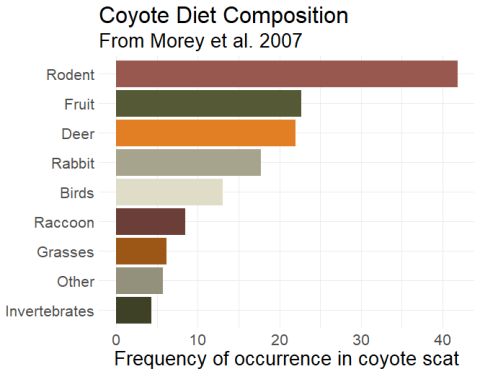Coyotes are opportunistic predators that eat a wide variety of foods. Coyotes are largely scavengers and hunters of small animals, but they will hunt larger prey occasionally. Coyotes also eat a number of plants and fruits, making their overall diet very broad and variable. This ability to live on a range of foods is part of the reason coyotes have been so successful in expanding their range. Many of the foods, both plant and animal, that are available to coyotes here in Ohio do not exist in their historic range in the western US. This makes it especially important to learn more about what Ohio coyotes are eating. As a relatively new species in the state, having become common only in the last 50 years or so, there has not been much research on diet specific to this area. Understanding what they eat, and how their diet overlaps with other carnivores, can tell us about what impacts they may be having on other species in the state.
Our project is doing an in-depth diet analysis for coyotes across Ohio. We are determining what Ohio coyotes are eating and whether coyote diet changes across different age groups, between sexes, and across different habitats in Ohio. We can learn from past research on coyote diets, but we need to take into account that Ohio's coyotes are likely a bit different.
There have been a few studies looking at midwestern coyotes. A study investigating coyote diet in the Midwest found that over 40% of coyote scats showed signs of rodents, while deer made up 22% and fruits 22.7%, as seen in the figure shown to the right (Morey et al. 2007). Closer to home, a 2004 study looking at 50 coyotes in the Cuyahoga Valley National Park found meadow vole remains in 28% of scats analyzed (Cepak 2004). That's nearly a third of the study's scat samples showing evidence of consumption of just one rodent species! Clearly rodents are an important part of the coyote diet, meaning coyotes are doing a lot of pest control for us.
Deer are still an important food source for Ohio coyotes, though it is unlikely that coyotes often hunt adult deer. They hunt fawns and take advantage of scavenging opportunities, such as roadkill.
Our project will build on this previous work, as well as look at how diet varies depending on habitat or region, as well as how individual coyotes might vary in the foods they eat.
Click to learn more about how you can help this work.
References:
Morey, Paul S, Eric M Gese, and Stanley D Gehrt. 2007. Spatial and temporal variation in the diet of coyotes in the Chicago Metropolitan Area. The American Midland Naturalist 158(1): 147-161.
Cepek, Jonathon D. 2004. Diet composition of coyotes in the Cuyahoga Valley National Park, Ohio. Ohio Journal of Science 104(3): 60-64.

